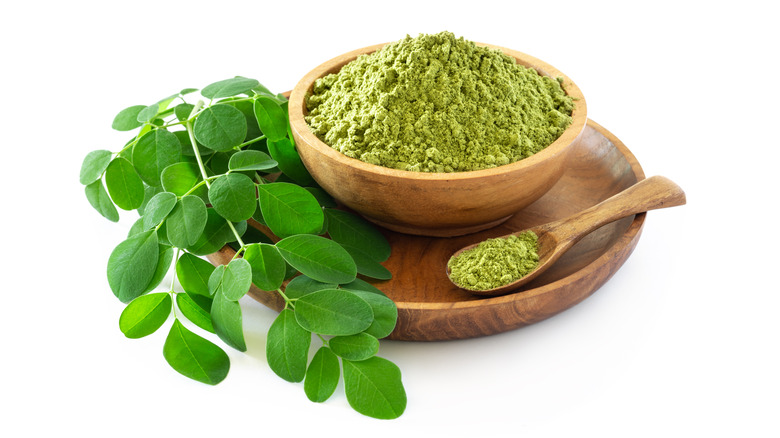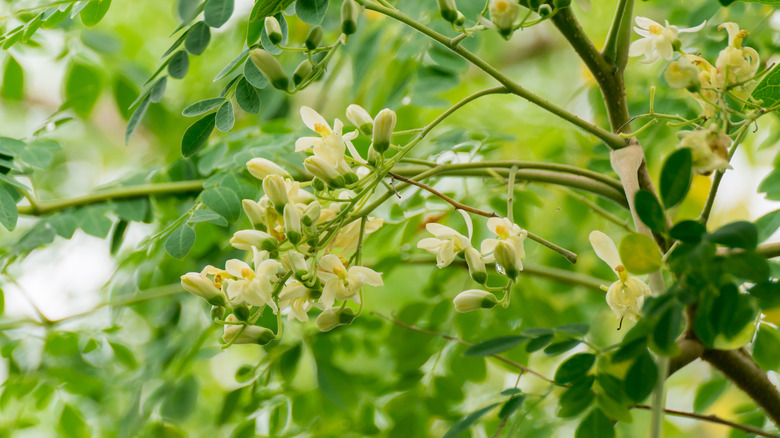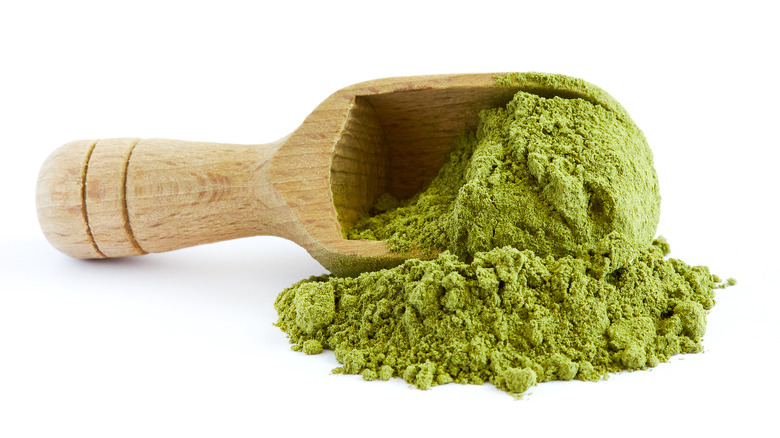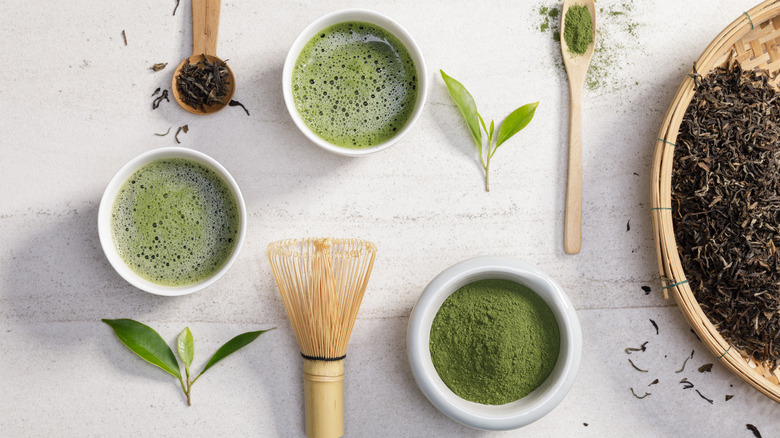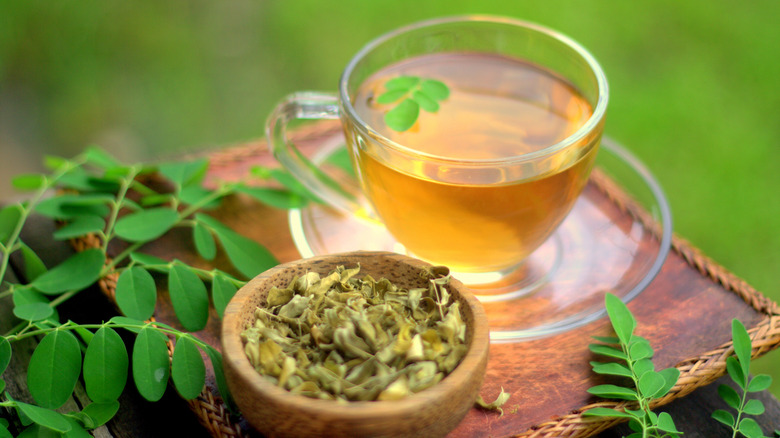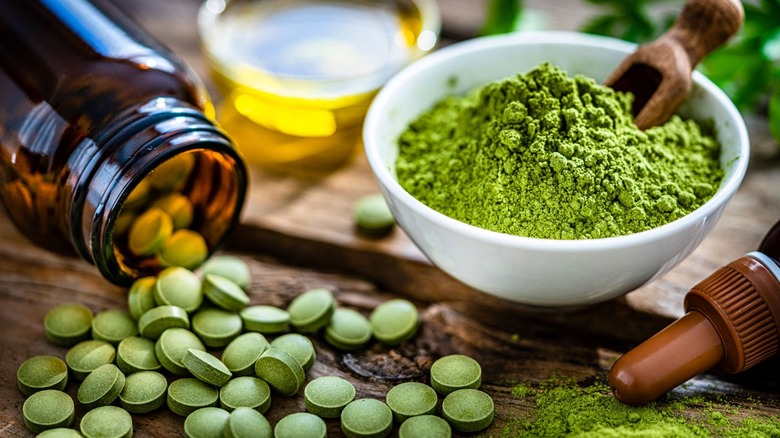What Is Moringa And What Does It Taste Like?
We may receive a commission on purchases made from links.
Also known as the drumstick tree, the miracle tree, and the horseradish tree, moringa (moringa oleifera) is a tree of many names (via Medical News Today). While it may not be truly miraculous, moringa is said to be about as close as you can get to a magical plant. Not only has it been used in ancient medicine for thousands of years, but it's packed with vitamins and minerals.
According to Vogue, moringa had its moment in the spotlight in 2017 when it became known as a superfood with plenty of health benefits. As with CBD, chaga, and other buzzy wellness supplements, moringa has been made into capsules, protein bars, powders, and more, per CBDfx. Popular moringa brand Kuli Kuli sells a line of gummies, tea, and fun holiday items like peppermint bark.
But that's not all — the plant has even made its way into skincare. Shape shares that Chrissy Teigen and Olivia Munn are fans of a face oil made with moringa and algae, and The Body Shop boasts an entire line dedicated to moringa.
There's no doubt moringa has had its 15 minutes of fame and then some, but is it truly worth the hype? Let's take a closer look at this ancient yet trendy superfood, and you can decide if moringa is all it's cracked up to be.
What is moringa?
According to the Food and Agriculture Organization of the United States (FAO), the moringa plant is classified as a tree. But unlike many other trees, every part of it is edible. That means you can technically eat the moringa tree's leaves, seeds, tubers, nuts, bark, and flowers — although we're not sure you'd necessarily want to.
There are multiple species of moringa plants under the moringaceae umbrella, although the one we know as the moringa tree, moringa oleifera, is the most well-known in America, per Britannica. And according to Minimalist Baker, moringa falls under the Brassicales order, making it a close relative of vegetables like broccoli and cauliflower.
Moringa trees can reach between 25 to 35 feet tall and grow best in tropical or subtropical climates, The Spruce shares. Because they prefer sunny temperatures, they're native to the Himalayan foothills but also grow throughout Africa (via FAO). According to Epic Gardening, moringa trees are characterized by their gray bark, small oval leaflets, and groups of white, delicate flowers.
If you're interested in growing moringa trees at home, it is possible — but much easier if you live in a warm climate. Because they thrive in temperatures between 77 and 95 degrees Fahrenheit, The Spruce states you'll want to bring the plants indoors if you live somewhere with cold seasons.
How is moringa powder made?
Moringa powder is made by crushing dried leaves from the moringa tree, according to Real Simple. If you're lucky enough to have a moringa plant at home, you can even make your powder. Instructables recommend spraying water on the leaves a few days before you want to pick them to get rid of any excess dirt and give them time to dry.
Alternatively, you can wash the leaves in a saline solution, Moringa Trees notes, but make sure to let them dry thoroughly afterward. Once your leaves are harvested, throw them in the blender and strain the resulting powder to eliminate any remaining unsavory bits.
When it comes to mass-producing moringa powder, there are several widely used methods. According to Moringa Farms, the most efficient one in the U.S. is to plant seeds in raised beds near a water source using composted soil. Once the shoots reach eight inches tall, which usually happens several times a year, the leaves can be harvested and ground into powder.
The leaf-washing process is also much more intensive for commercially produced powder. Indian supplier Medikonda washes their leaves twice, then sends them to a temperature-controlled dryer that retains the nutrients throughout the drying process. Once the powder is made, it's sterilized, so it's fit for consumption.
Moringa vs. matcha
It's easy to confuse moringa and matcha — their powders are green, sweet, earthy, and packed with health benefits. You can mix them into smoothies, soups, and baked goods for a nutritional boost.
So what's the difference between these two? First of all, they're from entirely different plants. While we covered that moringa powder comes from dried moringa tree leaves, matcha is made from the green tea leaves of the Camellia sinensis plant, according to Pure Leaf. We know that moringa is a relative of broccoli and cauliflower, while matcha is more closely related to fruits like blueberries and cranberries, per Succulent-Plant.
Both plants contain many antioxidants, but each has different types. Healthline shares that moringa is plentiful in vitamin C, beta-carotene, quercetin, and chlorogenic acid, while matcha boasts a high catechin content that's up to 137 times higher than other green teas.
But while there's no doubt they're both highly nutritious, perhaps the most significant difference is in the powders' caffeine content. Matcha has become a well-known coffee alternative due to its smoother caffeine release, while moringa has no energy-giving properties (via Minimalist Baker).
What does moringa taste like?
When you think of a green powder packed with vitamins and minerals, you may assume it doesn't taste great. And while some may not enjoy the flavor of moringa, reviews for the superfood plant vary widely. According to Vogue, moringa powder tastes like matcha with notes of blue-green algae. That may not sound too appetizing, but matcha is actually beloved for its mild, sweet, and earthy flavors. A moringa beverage may not be as delectable as a milkshake, but as far as healthy drinks go, it can be pleasant to sip on.
However, some may disagree. Your Super describes moringa as a little "sharp, spicy, and bitter." If you have an aversion to drinks that taste distinctly "green," you may not enjoy the taste of moringa. And if flavor is a concern, stick to the powder – Specialty Produce shares that the leaves can taste grassy with a horseradish-esque heat.
What people seem to agree on, however, is that moringa has a milder flavor than another popular green powdered supplement, spirulina. While it's essential (for your tastebuds' sake) to mix spirulina into foods that mask its flavor, like smoothies and soups, moringa may not deter you from drinking it quite as quickly. As wellness brand Aduna states, since moringa isn't an alga, its flavor isn't quite as robust.
How to cook with moringa
Moringa is usually consumed in two ways: as a leaf or as a powder. Although its powdered form is much more popular and versatile, some choose to cook them in stews or soups or sautee them as you would for kale (via Cooking Light). According to Moringa Miracle Cure, cooking the leaves eliminates some of the bitterness and even creates a pecan-like flavor, making it easier to consume.
However, the uses for moringa powder blow its leaves out of the water. Aduna explains that the simplest way to understand moringa powder's versatility is to consider it a replacement for spinach or herbs in any dish. You can easily add a teaspoon or two to liquids like smoothies, juices, dips, and sauces or even shake it into salad dressings.
But that's not all — moringa powder also works well on top of savory dishes like eggs, salads, or sourdough avocado toast, according to MindBodyGreen. And if you're a fan of caffeine-free morning beverages, mix some directly with hot water or enjoy a moringa-based tea.
If you'd like to make an entirely moringa-centered breakfast, go ahead and add it to your favorite baked goods. Brit & Co recommends using moringa powder to make pancakes, cupcakes, and even key lime pie. Just don't be alarmed if your bread turns bright green; while you can see proof that you used this powerful ingredient, you most likely won't be able to taste it.
Where to buy moringa
Due to moringa's popularity in the health and wellness world, you likely won't need to travel far to get your hands on this superfood. And luckily, moringa leaves are available all year long, according to Specialty Produce. If you have Whole Foods near you, scooping up a package of powder or tea should be no sweat. Target also has several capsule forms available.
Other supermarkets may sell moringa, like Vons and Walmart, in addition to specialty health food stores. Your best bets are to check the coffee and tea aisle to look for moringa tea or the health food section to see if they carry moringa powder next to other supplements. The most extensive moringa selection, however, can be found online. Amazon has many products, including teas, gummies, and powders. And if you're seeking a specific brand, Kuli Kuli Foods and True Moringa have a plethora of products.
However, take note that not all moringa is created equal, and there are a few things you can look for before buying a product. According to Eco Arava, the best moringa powders will be organic, made with 100% pure moringa oleifera leaves, and kept in vacuum-sealed packaging. If you can tell how long it's been since the leaves were harvested, you'll want to consume the powder within six months for maximum nutritious value.
Nutritional information about moringa
Moringa may have a pleasant taste, but its flavor isn't the reason it's been consumed for thousands of years. According to Science Direct, moringa has been traditionally used in Ayurvedic medicine to treat fevers, high blood pressure, diabetes, and more.
Medical News Today shares that moringa extract may remediate edema, stomach issues like constipation, and bacterial diseases like Salmonella. But that's just the tip of the iceberg — the long list of moringa's health benefits includes treating cancer, improving asthma symptoms, and even improving mood disorders like depression.
However, not all of these claims are backed by scientific evidence. For example, a study by KeAi Publishing concluded that while moringa has anti-diabetic and anti-cancer properties, more research is needed to determine if it can treat these two conditions. Additionally, WebMD explains there is insufficient evidence to say that moringa can be an effective treatment for diabetes, asthma, stomach ulcers, and other health issues.
It's also important to note that the FDA does not regulate moringa, and much of the research is still in the initial stages (via Medical News Today). WebMD advises that people who are pregnant or breastfeeding should stay away from moringa and warns that it may interact with medications that affect the liver or are prescribed for diabetes.
Other varieties of moringa
While moringa oleifera is by far the most popular variety of moringa in the U.S., it's not the only one that exists. According to Sustainable Bioresources, there are 13 types of moringa plants. The moringa we usually see falls under the slender tree category, but there are also moringa bottle trees, shrubs, and herbs. And while Frontiers in Pharmacology names moringa oleifera as offering the highest amount of nutrients, all 13 types have been used throughout Asia and Africa, per the National Library of Medicine. Their seeds have purified water, their flowers have produced honey, and their oil has even been used as biofuel.
Moringa stenopetala, one of the bottle tree varieties, is a popular plant native to East Africa, according to the Slow Food Foundation for Biodiversity. While it has yet to catch on in the U.S., it grows quickly and is resistant to drought, making it a relatively easy crop to cultivate.
In particular, people in the Konso area of Ethiopia love to eat moringa stenopetala leaves in damaa, a popular stew, per Make Projects. It can be grown at a time when other green vegetables aren't readily available, and its leaves, flowers, and pods are valued for their high nutritional content (via the International Journal of Agricultural and Food Research).
